ANDREW SALGADO
Andrew Salgado’s paintings have evolved greatly in style since first rising to prominence over half a decade ago with his (then) signature large-scale, painterly portraits, where large swathes of colour played across the surface to define his subjects. In his most recent work – the representational has given way to the more abstract: and now such colourful, symbolic, and compositional elements are the driving force of the painted image. While the figures remain a common thread – today Salgado’s subjects are depicted in a fantastical, often ominous tableaux. There are abundant references to the tradition of figurative painting both historic and contemporary: Matisse, Gauguin, and Bacon are all readily recalled; while contemporary greats like Tal R, Daniel Richter, and Peter Doig are also referenced with equal reverie and respect – often like quiet in-jokes for a viewer to catch. The artist’s long-standing tendency to paint clowns and the absurd remain constant (in 2016’s The Fool Makes a Joke at Midnight, the artist had actual circus performers in the exhibition space during the exhibition’s duration), and again one sees faces are painted in bright orange, with purple noses and vibrantly coloured hair. Where there once was a plain background, which placed the figure at the forefront of the image, now there is a kind of harmonious cacophony, a medley of pop-coloured squiggles, harlequin patterns, and wonky block shapes–all of which may seem hastily scribbled if it weren’t for the fact that they slot into one another like an impossibly orchestrated puzzle.
Salgado’s more recent works have made a noted effort to distance himself from a 2008 assault (in which he was attacked for being a gay man), and are decidedly certainly more irreverent than his previous offerings: brighter, more celebratory, even theatrical. The artist carries this sense of play into his exhibitions, too. For The Snake (BEERS London, 2016), hundreds of butterflies were released to flutter amongst the audience as if they had burst from the artworks themselves; A Room with a View of the Ocean (Lauba House, 2017) saw an 8-metre ocean projection (and artificial ‘beach’) on the final room’s wall, inviting the audience to partake in a meditation of what they had seen; and the two-day-only exhibition Nature Boy (BEERS London, 2018) saw a pianist (at a baby-grand!) playing the eponymous song on repeat for the entirety of the show’s duration. For Salgado, similar to his increasing use of collaged elements, an exhibition is an opportunity to extend elements of the painting beyond the canvas–an invitation into his world of colour, fantasy, and fun.
ANDREW SALGADO (b. 1982, Regina, Canada) lives and works in London, England. He graduated with an MA in Fine Art from Chelsea College of Art and Design in 2009, and has since had 13 sold-out solo exhibitions held all over the world, and is widely regarded as one of the UK’s leading young figurative painters. In 2017, Salgado was the youngest artist to ever receive a survey-exhibition at The Canadian High Commission in London, accompanied by a 300-page monograph, both of which were entitled TEN. Previous solo exhibitions include, Blue Rainbow, Angell Gallery, Toronto, (October 2018); Nature Boy, BEERS London, (2018); Dirty Linen, Christopher Moller Gallery, Cape Town (2018), A Room with a View of the Ocean, Lauba Art House, Zagreb (2017); The Snake, BEERS London, (2016); The Fool Makes a Joke at Midnight, Thierry Goldberg, New York (2016). He has exhibited his work at various international art fairs, including Zona Maco, Mexico City (2019); Pulse Miami (2016); and Volta Basel (2015). In 2015, Salgado curated The Fantasy of Representation, including work by Francis Bacon, Gary Hume, and Hurvin Anderson, with an impassioned manifesto on representational painting. In 2014 he was the subject of a documentary, Storytelling. He has received extensive press both online and in print, including GQ, The Evening Standard, The Independent, Artsy, METRO, Attitude Magazine, Globe and Mail (CAN) and Macleans (CAN). He frequently donates to charities including Pride London, Stonewall, and Diversity Role Models; his donations to the Terrence Higgins Trust are of particular note, having have raised over £75,000 in 5 years. In March 2019, he successfully entered the secondary market with a piece in a Strauss & Co auction in South Africa. Forthcoming solo exhibitions include a booth over Basel Miami (TBA, December 2019); and a fourth solo at BEERS London (October 2020). His works have been collected extensively in private and public collections worldwide.


